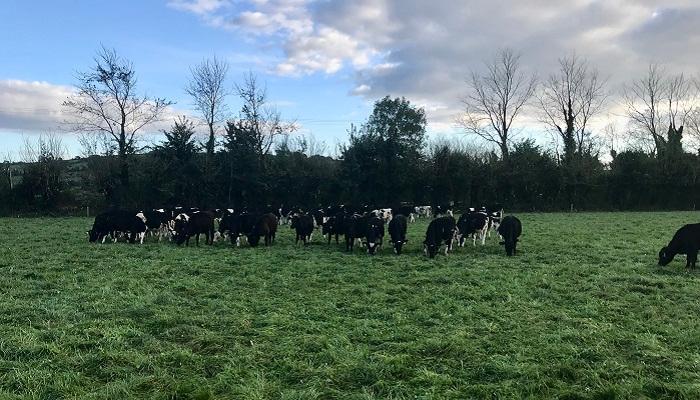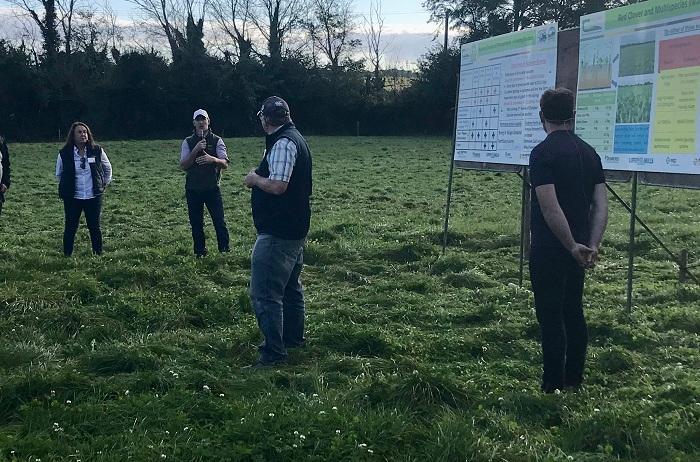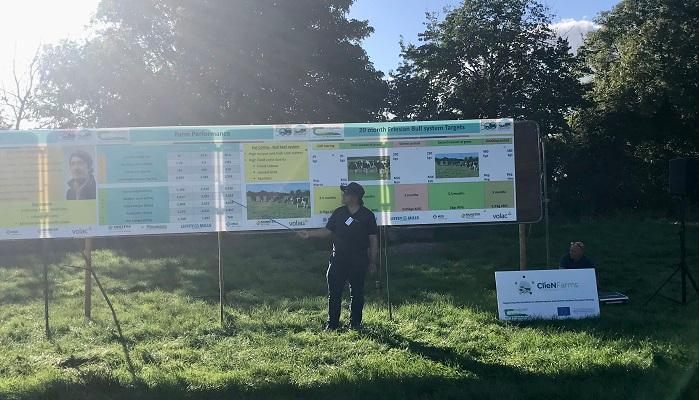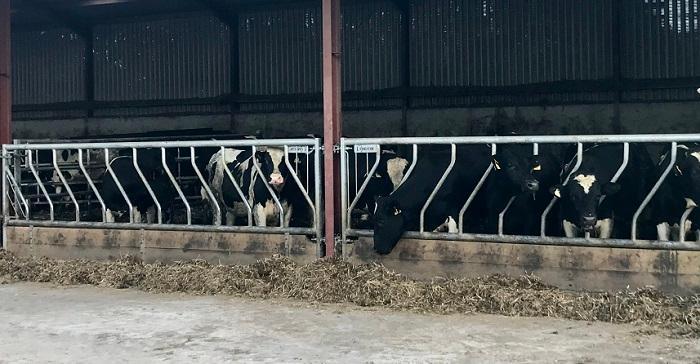29 October 2023
Creating a unique advantage with beef and tillage in east Cork

Located just outside Castlemartyr, Co. Cork, Pat Collins operates a sizeable calf to beef and tillage enterprise, which centres on the use of home-grown feeds – whether grazed or ensiled grass or tillage crops – to create a resilient and profitable farming business.
One of 15 farmers enrolled in the Teagasc DairyBeef 500 Campaign, Pat is an early adopter and has implemented new technologies – namely the inclusion of red and white clover and multispecies swards – to help farm in a more sustainable and economically efficient way.
Centred on the production of 20 month dairy-bred bulls and a small number of early-maturing heifers, an overview of Pat’s system was provided at a recent DairyBeef 500 farm walk.
Operating on mostly rented land, Pat’s grassland area has almost doubled over recent years, climbing from 26.5ha in 2018 to ~52ha in 2023. This area comprises of grassland, consisting of white clover and red clover grassland swards and multispecies swards, with the latter being a relatively new addition following their establishment in the autumn of 2022.
Commenting on the uptake of technology on the farm, Pat said: “We strongly believe that there is a good living to be made from farming. Going forward, every farmer needs to adapt new technologies on their own farms to see what works for them. We are very conscious of trying new technologies to improve performance and profitability, whilst also trying to reduce the gaseous emissions on our farm.
“On our farm, slurry is applied using low emission slurry technologies. We have included red clover and multispecies swards in our grassland swards to improve the quality of high protein silage and to reduce chemical nitrogen applications.”

Pat Collins, centre with microphone in hand, speaking at the recent DairyBeef 500 farm walk on his farm
The system
Over 300 calves were purchased on the farm this spring, at approximately 21 days of age. Reared artificially and weaned off milk at 10 weeks, they consisted mainly of Holstein Friesian bulls and 38 heifers. These heifers will either be sold as stores next year or slaughtered off grass in October/November.
All male animals on the farm are finished as bulls. This year, 193 bulls will be finished before Christmas. The first batch of 118 bulls were housed in early August, with slaughtering targeted at 19-21 months. The remaining bulls stayed at grass until late August, at which point they were housed and introduced to a total mixed ration diet containing home-grown ingredients from the tillage enterprise.
Calf purchasing and health
Calves are purchased directly off local dairy farms, leading to less stress due to the shorter transport times and it also lessons the likelihood of diseases being transmitted due to no mixing of calves in marts.
A vaccination programme is also being implemented. Once on the farm a few days and calves are acclimatised, an intranasal vaccine to protect against RSV and Pi3 is administered, as well as an oral drench for coccidiosis. At turnout, calves are given a vaccine against black leg, with a follow on booster given at four weeks. At housing, weanlings are once again given an intranasal vaccine to protect against RSV and Pi3.
Discussing the weaning protocols for calves, Pat explained: “We try to make improvements to our calf rearing policy every year. Depending on how calves have performed on milk, we typically wean once they are eating enough ration. At the point of weaning, the calves could be consuming 2kg/head of ration. If I am not happy with a calf at weaning, it will stay on milk for a while longer.
“Calves are left settle for a week after weaning and are then turned out to grass with ad-lib access to concentrate. Over the space of a couple of weeks, ration feeding levels are reduced down to 1kg/head/day to encourage grass intake.
“Once calves are consuming sufficient quantities of grass, the ration tends to be taken out of the diet, before being returned in approximately September or when grass quality and dry matter levels begin to drop.
“We monitor calf performance constantly and regroup the calves occasionally, taking some of the lighter calves out to give them a little more attention in their own separate group.”
Weight gain targets
Gordon Peppard, DairyBeef 500 Advisor to the farm, highlighted the importance of achieving weight gain targets and why the management of calves in their first year on farm is so critical in achieving this.
Gordon explained: “Animals need to perform every day they are on farm in a calf to beef system and Pat’s farm is no different. The objective of the calf rearing period is to bring a calf from approximately 45kg to 95-100kg at the point of turnout. That can only be achieved through the correct nutrition and keeping animals healthy.
“From turnout to housing in the first year, daily weight gains of 0.7-0.8kg/head/day are targeted, with bulls ideally weighing 240kg at housing in the middle of November.

Gordon Peppard, DairyBeef 500 Advisor, discusses the financials and weight gain targets on Pat Collins’ farm
“Pat has a dry farm so a three month winter is targeted. Over this period, daily gains of 0.6-0.65kg/head/day a targeted and to do that you need to feed high-quality silage.
“A lack of performance over the winter months is an issue we see on some farms and it’s important to test your silage and make your meal feeding decisions on the basis of silage quality. The amount of meal you will feed to achieve this level of performance all depends on the quality of silage you have.”
After the winter period, Gordon noted, bulls on Pat’s farm should weigh 290-300kg. From this point, they are turned back out to grass, where daily weight gains of >1kg/head/day are targeted to achieve a liveweight of 460kg by August.
At this point, the housing of the heaviest bulls for finishing begins. Over the course of an average finishing period of 80-90 days, the bulls are expected to reach a liveweight of 600kg to produce a 300kg carcass at slaughter.
A grassland focus
Grazed grass plays a central role in the bull beef system being operated at Dower Farm, Castlemartyr. Due to the soil type, an extended grazing season can be achieved annually, with turnout typically occurring in early February and housing date often dictated by closing farm cover rather than ground conditions.
The housing of bulls from August onwards also has benefits in terms of the farm’s grazing season length. With finishing bulls being indoors, the grazing season for the weanlings can be extended, which also serves to reduce the risk of poaching damage.
Soil fertility and grazing infrastructure are excellent, with the farm laid out in manageable paddocks with suitable access and watering points – both of these are necessary elements in maximising the utilisation of grass. Grass is also measured weekly and this information is used to make informed decisions on grass budgeting and planning, with surplus bales taken out at points throughout the year in which grass growth levels exceed demand to not only maintain grass quality but to also maximise animal performance from grass.
Highlighting the importance of gains from grass on his farm, Pat said: “Grass is by far the cheapest asset available to any livestock farmer in Ireland, why wouldn’t you look after it? If you don’t measure it, you can’t manage it.
“We have a dry farm here and we work to our strengths. If it’s fit to graze in the spring, we graze and you don’t have to spend a fortune on infrastructure to have flexibility.”
The role of red clover and multispecies swards
After initially experimenting with one paddock of red clover, Pat has extended this area to 16ac. His ambition is to have enough red clover silage to replace any bought in protein. If successful, it will mean that all feedstuffs required for the beef enterprise, with the exception of milk replacer, will be produced from within the farm’s gate.
“Our long-term plan is to potentially introduce red clover into the arable rotation, as it is a very suitable break crop. The red clover we have currently is getting zero chemical nitrogen and is grown with slurry and 0:7:30,” Pat commented.
2023 marks the first year in which multispecies were grazed on Pat’s farm, adding: “It’s a big winner for us. It only received 35 units/ac of nitrogen this year and I think there is a big possibility that it didn’t need that fertiliser, but I’m just not ready to take the gamble of running out of grass in the spring or end of the year.
“It’s on rented ground, so it has to pay for itself. It’s a low maintenance crop and it’s suiting our system so far – good graze outs and cattle are content. At the moment, I don’t see any negatives with them,” Pat concluded.
Physical and financial performance
Giving a caveat before outlining the financial and physical performance on the farm, Gordon said: “A 20-month Friesian bull system is not a system we are promoting. If you are doing this system, you need to have a relationship with your factory to ensure that those animals are wanted by the factory and can be sold.”
Pat’s bull beef system is high output, but also high cost. All costs of grain, beet, maize etc. that are used in the finishing period are fully costed against the beef enterprise and credited to the tillage enterprise. As the majority of the grassland area is rented, this is a significant cost to the system, while outside labour costs are also included.

In 2022, the net profit was back compared to 2021. This was largely due to the increased costs of inputs and particularly feed and fertiliser. The bull finishing system that Pat runs would have significant meal and other feed inputs and at increased prices in 2022, it would have impacted the bottom line. Also, similar to all farms, fixed costs took a jump with the increasing cost of energy etc.
Another point to note is the stocking rate outlined in the table below appears very high for a calf to beef enterprise. However, on the ground, this is diluted by the tillage lands, which provide winter feed for growing and finishing animals.
Table 1: Financial and physical performance on Pat Collins’ farm
| Year | Cattle area | Stocling rate | Gross output | Gross output | Gross output | Variable costs | Gross margin | Fixed costs | Net margin |
|---|---|---|---|---|---|---|---|---|---|
| Ha | LU/ha | Kg/ha | Kg/LU | €/ha | €/ha | €/ha | €/ha | €/ha | |
| 2022 | 36.4 | 3.85 | 2,301 | 598 | 6,256 | 3,624 | 2,633 | 1,865 | 768 |
| 2021 | 34.4 | 3.40 | 2,461 | 723 | 5,314 | 2,491 | 2,823 | 1,531 | 1,293 |
| 2020 | 30.0 | 3.29 | 2,682 | 814 | 5,286 | 2,877 | 2,409 | 1,270 | 1,140 |
| 2019 | 26.5 | 2.80 | 2,000 | 715 | 3,154 | 2,105 | 1,049 | 1,107 | -59 |
| 2018 | 26.5 | 2.25 | 1,967 | 876 | 3,682 | 2,068 | 1,614 | 1,194 | 421 |
On the future plans for the farm, Pat will continue to seek good quality bull calves and the sourcing of calves in the future will be further focused on their Commercial Beef Value. Additionally, maximising performance at grass – whether permanent pasture or multispecies swards – is critical to have bulls at target weight before the finishing period to maximise output and reduce finishing time.
Also read: Growing and refining a calf to beef system in Co. Mayo
